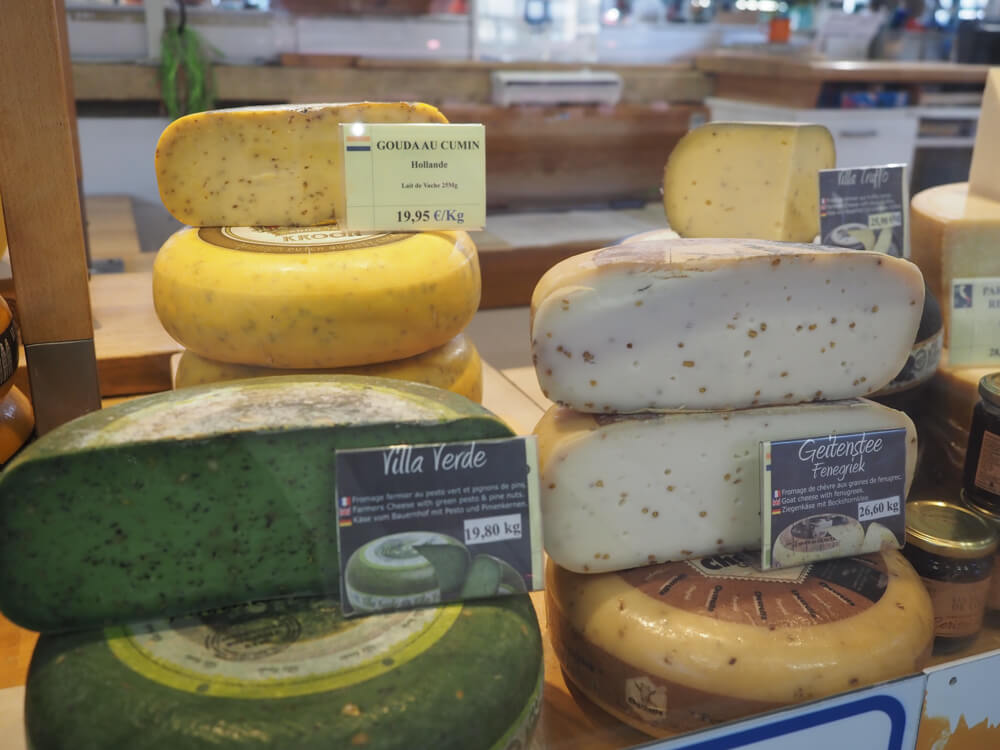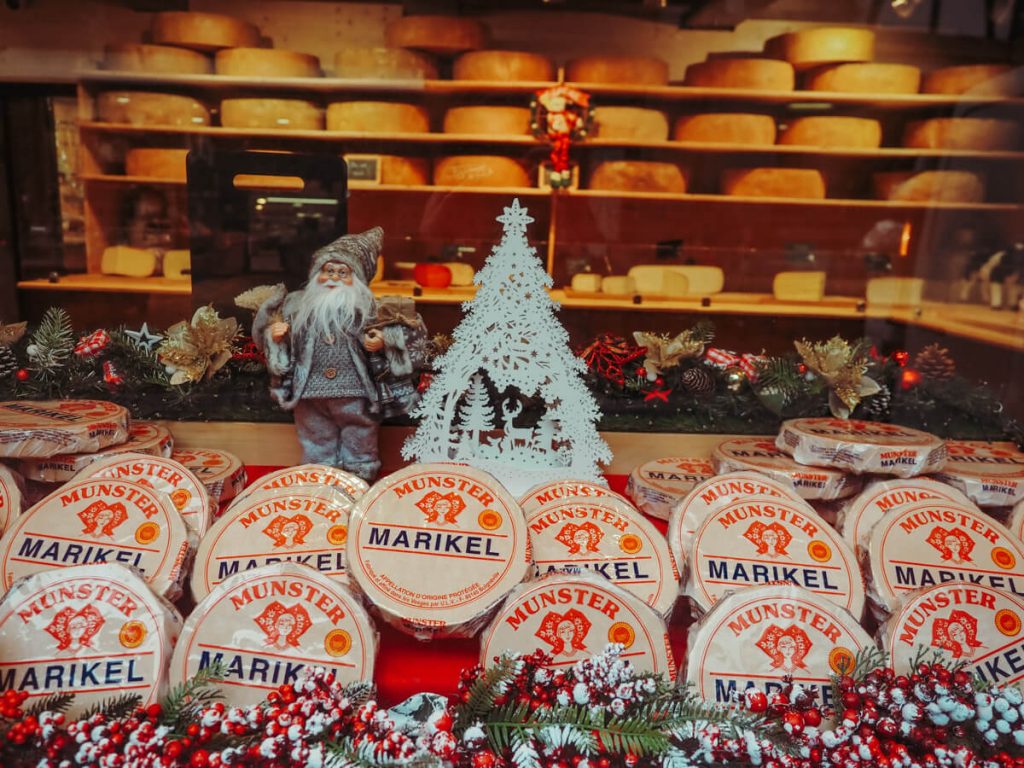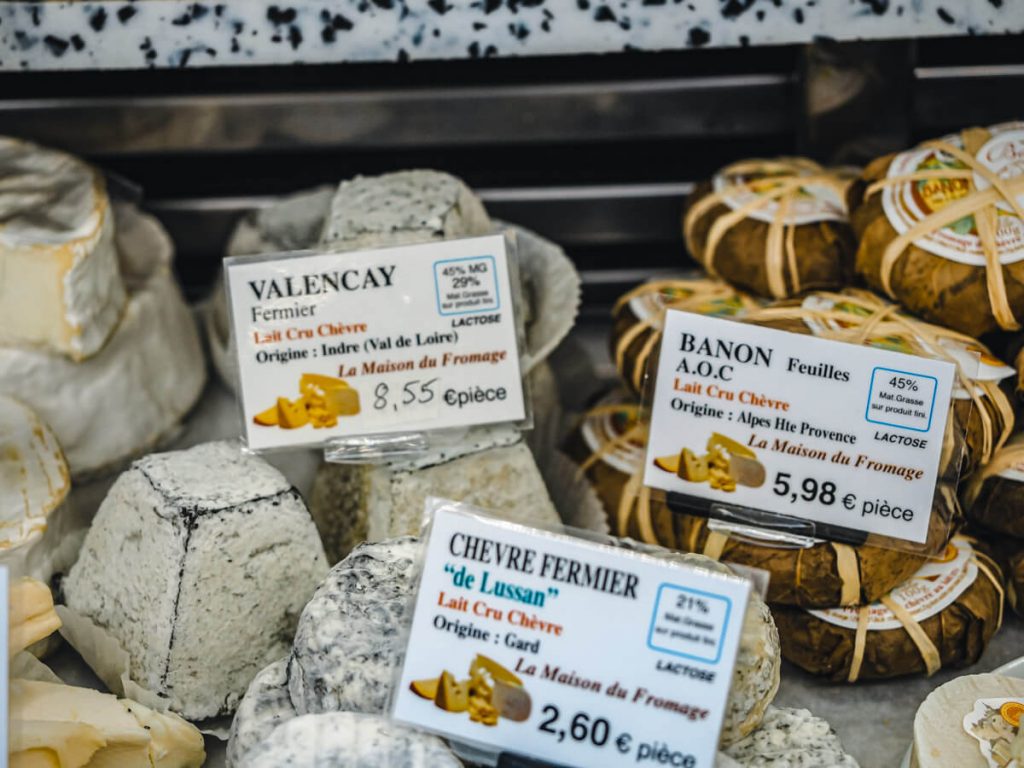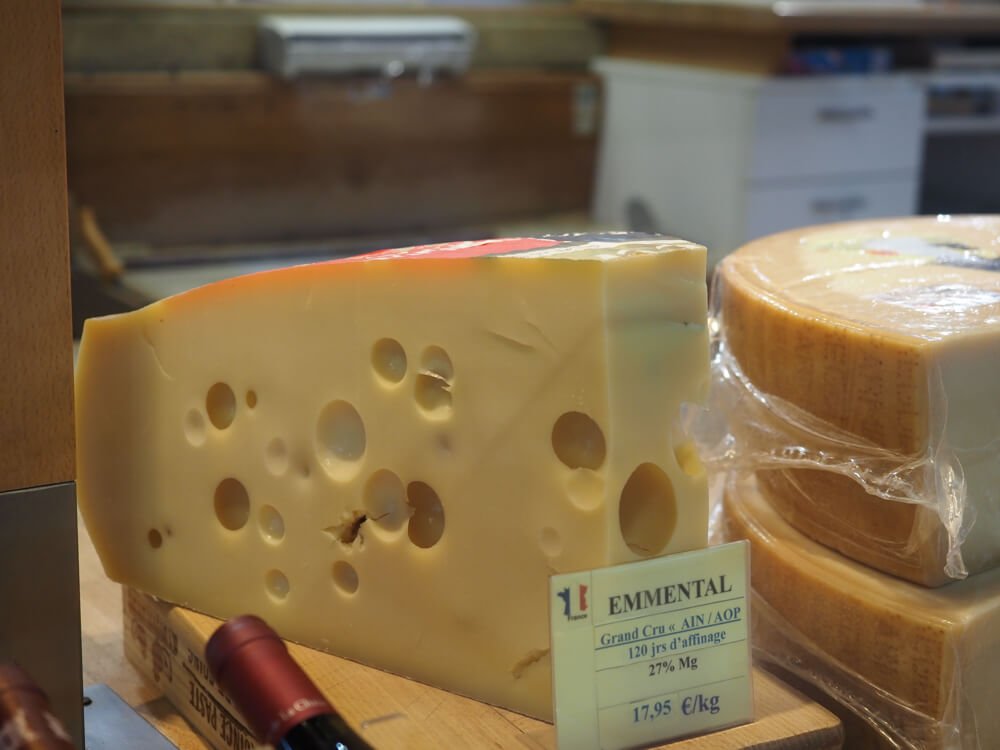Some posts on this site contain affiliate links, meaning if you book or buy something through one of these links, I may earn a small commission (at no additional cost to you!). Read the full disclosure policy here.
Ahh, French cheese. I think it is safe to say that France is the land of cheese. Seriously, nobody does it better than France, in my humble opinion. And it makes sense when they have between 1,000-1,600 varieties of cheese ranging from soft, gooey Brie to hard and delightful Beaufort. So narrowing down the best French cheeses is definitely a challenge.
But don’t worry. After years of visiting France, and eating my fair share of cheeses, I’ve made a list of the best French cheeses to try during your trip.
So whether you want a cheese that just melts into your baguette or a sturdier snacking cheese, these are the cheeses of France that you’ll love!

Contents
- Designations of French Cheese
- 27 Best French Cheeses to Try
- Best Soft French Cheeses
- 1. Brie
- 2. Camembert
- 3. Epoisses
- 4. Mont d’Or
- 5. Pont-l’Eveque
- 6. Reblochon
- 7. Neufchatel
- 8. Saint-Marcellin
- 9. Langres
- 10. Maroilles
- 11. Munster
- 12. Boursin
- Best French Bleu Cheeses
- 13. Roquefort
- 14. Bleu d’Auvergne
- Best French Goat Cheeses
- 15. Bouton de Culotte
- 16. Rocamadour
- 17. Bucheron
- 18. Valencay
- 19. Banon
- Semi-Hard French Cheeses
- 20. Comte
- 21. Emmental
- 22. Raclette
- 23. Tomme de Savoie
- 24. Saint-Nectaire
- 25. Abondance
- Hard French Cheeses
- 26. Beaufort
- 27. Mimolette
Designations of French Cheese
Before we get started, you need to know that while France produces a lot of cheese, they take quality seriously as well. Many even have various designations that can be quite strict in regards to how the cheese is made and where it is from.
Here are the distinct designations to look out for among popular French cheeses you’ll spot.
AOC: Appellation d’Origine Contrôlée, or Controlled Designation of Origin. This is the highest level of protection and protects the ingredients and method of making the cheese, as well as where it is from. For example with wine, Champagne can only be called that if it comes from Champagne.
AOP: Appellation d’Origine Protégée or Protected Designation of Origin. This means everything in regards to the cheese is from a certain region including the milk, where it was processed into cheese, and even the aging was done in a certain region. It is the same as AOC, but with a European designation instead of just French.
IGP: Indication Géographique Protégée or Protected Geographical Indication. This means that either the cheese was produced, processed, or refined in a particular region. So it can bear this designation if the milk was from one region but was processed elsewhere.
Most French cheeses end up falling into the AOC/AOP category, and if you see AOP on the label of your cheese in France, you know you’ve got a good one.

27 Best French Cheeses to Try
To break it down, I’m going to sort the list into French cheese types including hard, soft, semi-hard, goat cheese, and blue cheese.
Best Soft French Cheeses
1. Brie
I can almost guarantee that if you’re a cheese lover, there is a 100% chance you’ve had this type of cow’s milk cheese before. Easily the most popular French cheese, this beloved soft cheese with its signature white rind is all over grocery store shelves around the world.
There are ample varieties of Brie made in France and worldwide including Brie with truffles, as well as double or triple cream Bries.
Originally from the Ile de France region of France, for the best quality, opt for the AOC/AOP Brie de Meaux or Brie de Melun. Brie de Meaux is known as the “Queen of Cheeses.”
The outside rind is a bit firm and the inside is soft and creamy but still holds its own. It is popular to just eat on crackers or a baguette.
Aged: 5-6 weeks.
Pasteurized: Not traditionally.

2. Camembert
Slightly similar to Brie, Camembert is its Normandy cousin, and extremely delightful. It is said that Camembert got its origins from Marie Harel in Normandy, after following instructions from a priest in the town of Brie.
She made some adjustments and voila! Camembert. But it is also likely that it came from the industrialization of cheese making at the end of the 1800s. In the end, we’re thankful it exists.
This popular cheese can be found around the world as well and is known to be a bit creamier and more pungent than Brie.
For the AOC/AOP version of Camembert, look for Camembert de Normandie.
Like Brie, this is a great addition to any French cheese board.
Aged: At least 3 weeks.
Pasteurized: Not traditionally.
3. Epoisses
This famous, or infamous, French cheese is well known for being one of the stinky French cheeses. It is so smelly, that it is even banned on public transportation!
Despite its smell, however, this is a much-loved French cheese, and don’t worry, it tastes much better than it smells.
Epoisses come from the Cote d’Or department of France, and this cow’s milk cheese was originally made by monks in the sixteenth century. It was even beloved by Napoleon.
It has a nice orange rind and the inside is very soft, perfect for spreading! This is an AOC/AOP cheese.
Aged: At least 6 weeks.
Pasteurized: Sometimes.

4. Mont d’Or
Mont d’Or, or Vacherin du Haut-Doubs, is a cheese from Franche-Comte made from cows. This is a washed-rind soft cheese with a gray and yellowish exterior and is nice and soft on the inside.
It is typically a seasonally made cheese and is served in the winter after the cows return from the alpine pastures. Typically, you’ll find it served warm, with it being baked in the wooden case it comes in. It is then eaten like fondue in all its gooey creamy funkiness.
You’ll find this with a mark of AOP.
Aged: 5-7 weeks.
Pasteurized: Not traditionally.
5. Pont-l’Eveque
This Normandy cow’s milk cheese has origins dating back to the 12th century, and was possibly made by Cistercian monks!
This ancient cheese is quite popular in France, but for tourists, it isn’t nearly as popular as its soft cheese counterparts like Brie and Camembert.
But it is well worth a try! Enjoy its smoothness and pungent aroma. Definitely eat at room temperature for the best taste, and it goes well as a dessert cheese. This cheese is also protected with an AOC/AOP designation.
Aged: 4-6 weeks.
Pasteurized: Both pasteurized and unpasteurized.
PS- You can try this while exploring the Normandy Cider Route!
6. Reblochon
If you’re anywhere near the Alps, like the charming town of Annecy or Grenoble, you’ll likely spot this cheese as a big component of the delicious tartiflette, a dish made from potatoes, lardons, and onions and topped with Reblochon.
It is seriously tasty, and a staple during the winter months, especially in the Haute-Savoie and Savoie departments.
It is nice and nutty and has an interesting history. Back in the day (14th century that is), farmers in this part of the country were taxed based on the milk their herds made. So they’d hold back some and not fully milk the cows until after taxes were paid.
The remaining milk was even better and could be made into this rich cheese. This cow’s milk cheese has its own AOC/AOP.
PS- If you’re searching for this in the US, unfortunately, you won’t be able to find this unpasteurized cheese. It’s been banned here, so you’ll have to go to France to get it!
Aged: 6-8 weeks.
Pasteurized: No.

7. Neufchatel
It certainly seems like Normandy is famous for its soft, creamy cheeses, and Neufchatel is no exception. This cow’s milk cheese has been around since the 1000s and may even date back to the 6th century.
And this cheese can even come in an adorably shaped heart, making it perfect for a romantic picnic (or proposal?).

It is saltier, sharper, and grainier than its other bloomy rind counterparts, but is enjoyable all the same. This is an AOC/AOP product and should be fairly easy to spot in cheese shops as it is mostly produced in that iconic heart shape.
This is a great creamy French cheese that works well on a cheese board or slathered on bread.
Aged: 8-10 weeks.
Pasteurized: Sometimes.
8. Saint-Marcellin
This cow’s milk cheese comes from the Rhone Alpes and is dusted with white yeast. There are actually 3 types of ripening for this cheese, including sec, cremeux, and bleu. The texture can vary based on aging and can be eaten as is on a cheese board or even heated up to make it all nice and gooey.
It has a more mild, salty taste with some nuttiness and fruit as well. It is very versatile and can be made into a dessert cheese or just smeared on a baguette.
Fun fact: it used to be a goat’s milk cheese before transitioning into a cow’s milk cheese later on.
Aged: About a month.
Pasteurized: Sometimes.
9. Langres
Another cow’s milk cheese with its own AOC/AOP designation, Langres is found in the Champagne region of France.
It is aged for about a month prior to being washed with brine and annatto, giving it that orange hue. It also has a concave top and is known for having a thicker texture but is also creamy.
This is definitely one of the stinky French cheeses but is definitely less bold and pungent compared to Epoisses. Pair it with Champagne for best results.
Aged: At least 5 weeks.
Pasteurized: No.

10. Maroilles
This cow’s milk cheese comes from the north of France in the Hauts-de-France. It also has that AOC/AOP designation and comes in square blocks, and has a distinct orange-red rind.
This is one of the strongest French cheeses, with its especially pungent aroma. It is said to have been made in 962 by a monk in the Abbey of Maroilles. It was even a favorite of French kings like Phillip II, Louis IX, Carles VI, and Francis I.
Aged versions of this cheese definitely have a strong scent of fermenting fruit, and it has earthy flavors on the palette.
It is a great end to a meal, especially when paired with a French cider, or sweeter white wine.
Aged: 2-16 weeks.
Pasteurized: Both pasteurized and unpasteurized.
11. Munster

This soft cow’s milk cheese is from the Alsace region of France, where it was originally aged in monk cellars.
Sometimes confused with other Munsters outside of the PDO region, and even with muenster cheese in the US, this cheese has its own AOC/AOP and is quite different from those, especially the American version.
This version is soft on the inside with a rind on the outside, and while the taste is more subtle, it does have a strong smell.
It is best enjoyed either on bread or even made into a Munster tartiflette. Pair it with an Alsatian wine for best results.
Aged: 5 weeks to 3 months.
Pasteurized: No.

12. Boursin
You have likely heard of Boursin if you’re a cheese lover, especially as it is easy to find outside of France. This cream cheese-like cheese is made from cows and comes from Normandy.
It is a soft, creamy cheese that usually has flavoring to it, with garlic and herbs being the most popular flavor. It really is a great crowd-pleasing party cheese, and you can enjoy it with a nice sturdy cracker or slice of bread.
Aged: 10 days.
Pasteurized: Yes.
Best French Bleu Cheeses
After all of that tasty soft cheese, it is time to talk about bleu cheeses. France makes an abundance of tasty bleu cheese, and honestly, it is some of my favorite cheeses from France!
13. Roquefort
Easily one of the best, if not best, bleu cheeses in the entire world, this sheep’s milk cheese hails from Aveyron and definitely has strict AOC/AOP regulations.
Even EU law states that Roquefort must be aged in the natural Comalou caves of Roquefort-Sur-Soulzon.
Often called the “King of Cheeses,” it is rumored that the ancestor of Roquefort was even mentioned by Pliny the Elder in 79 AD. Either way, this cheese has some lovely dark blue veins that give it quite a sharp tang. It is nice and crumbly and has quite a bit of funk.
While definitely delicious on its own or as part of a cheese board, it is also used in regional cuisine in the area for sauces, tarts, quiches, and more.
Aged: 5 months.
Pasteurized: No.

14. Bleu d’Auvergne
Hailing from Auvergne, this AOC/AOP cheese has iconic blue veins and a strong, pungent taste. It is also nice and creamy.
While you could just add this to some bread and enjoy it, it is also used in sauces and dressings. If you’re a lover of all things bleu cheese, then this cow’s milk cheese is one to add to your board.
Aged: 2 months.
Pasteurized: Sometimes.
Best French Goat Cheeses
Yes, even goat cheese needs its own category. France makes cheese from goats, sheep, and cows, and you can find some delectable goat cheeses around the country. Here are some favorites.
15. Bouton de Culotte
This adorable little cheese is much-loved and sometimes a bit pricey. The name “bouton de culotte” even means “trouser button.” Its soft rind can vary in color from white to yellow and even slightly brown.
Made in the Maconnais in Burgundy, this goat cheese is best paired with a nice Burgundian wine. This tiny little cheese packs a punch with a nice goat, pepper, and salt taste on the palette.
Aged: 2 months.
Pasteurized: No.
16. Rocamadour
This soft and round cheese comes from the southwest of France in Perigord and Quercy. It has an AOC/AOP and comes from the family of Cabécous.
It can be consumed quite young when it is creamy and sweeter or after being aged a bit when it firms up and gets a more earthy flavor.
This is a pretty versatile cheese as well as it can be eaten on its own with some wine or used in many regional dishes or melted onto bread.
Aged: 12-15 days.
Pasteurized: No.

17. Bucheron
When one thinks of goat cheese, one may picture this cheese that comes as a log.
Bucheron hails from the Loire and has a nice bloomy rind. When eaten young it has a mild flavor and is firmer. As it ages the flavor grows and it softens up. It is best eaten on salads or as an addition to your French cheese board.
Aged: 5-10 weeks.
Pasteurized: Sometimes.
18. Valencay

Another Loire cheese, this blue-grey cheese’s color comes from the mould plus the addition of charcoal.
This AOC/AOP designated cheese has a fun truncated pyramid shape with a bit of a story. The legend goes that it used to be a pyramid, but after Napoleon’s terrible campaign in Egypt, he came by the castle at Valencay.
He was so disgruntled by the sight of the cheese and how it reminded him of his defeat that he chopped off the top with his sword. The shape has been the same ever since.
Valencay’s flavor changes over time, with the younger version having a more citrusy taste, and then it transforms to a nutty taste upon aging.
Pair it with a Sancerre and you’ll feel like a king yourself.
Aged: About 3 weeks.
Pasteurized: No.
19. Banon
Likely the prettiest packaged of the French cheeses, this goat cheese is wrapped in chestnut leaves tied together with raffia.
This cheese potentially dates back to the Gallo-Roman period and has a nice, creamy, tart, and nutty flavor.
This is another great cheese board cheese and goes well with a nice glass of white wine. But be warned, it definitely has a funky aroma.
Aged: At least 3 weeks.
Pasteurized: No.

Semi-Hard French Cheeses
It is now time to talk about the incredible semi-hard cheeses in France. These make great additions to recipes or are perfectly eaten on their own. Let’s get into it.
20. Comte
This ever-popular cow’s milk cheese comes from the Franche-Comte region in eastern France. It is known as an alpine cheese and is the most produced AOC/AOP cheese.
In fact, you can find Comte sold both as is or even as shredded cheese at grocery stores in France, and it is a great addition to many recipes or even just eaten on its own.
Seriously, this versatile cheese is fairly mild with its fruity, sweet, salty, and nutty flavor that you can’t go wrong with whatever you want to do with it.
Aged: 4-24 months.
Pasteurized: No.
21. Emmental
In the US, this type of cheese would look like what we call Swiss cheese. It has a white-yellow color and has nice little holes in it.
While Emmental is made in Switzerland, it is also made in France. It is made in Vosges, Franche-Comté or Savoie. It’s a pretty mild cow’s milk cheese and honestly goes with so much. It is used in many recipes including omelets, pasta, salad, and even fondue, as it gets nice and melty.
You can also find this in grocery stores cut into wedges or shredded cheese.
Aged: 75-120 days.
Pasteurized: Not traditionally.

22. Raclette
This cheese is always a favorite in the Alps and is a Christmas market staple. Seriously, I’ve even seen it offered at a market in Cologne!
While traditionally a Swiss cheese, it is also made in France and very popular here. This cow’s milk cheese is served at many alpine restaurants by being cut in half and placed under a special heat lamp.
Then, you scrap off the melty cheese and put it on potatoes, meat, and other vegetables. The flavor is fairly mild and nice and smooth/buttery.
Many people also have “raclette parties” and you can purchase a raclette grill where you put slices of the cheese in little drawers in the grill and grill meats and vegetables on the top. Then, you pour the melted cheese over the accouterments and enjoy.
This is honestly the best cheese to enjoy during winter when hearty alpine dishes are so great- perhaps after a day of skiing?
Aged: At least 3 months.
Pasteurized: Not traditionally.

23. Tomme de Savoie
This AOC/AOP cheese can be found at markets all over the Savoie near the French Alps. It has a nice beige interior and a tough, brown-grey rind. This cow’s milk cheese has a nice mild and earthy flavor and can be paired with a good Savoie wine or some bread and fruit.
And fun fact- the flavor can change based on the time of year you buy it depending on what the cows were eating!
This alpine cheese is unique in that its history goes way back to ancient times, and actually has lower fat than most French cheeses.
That is because it is made with leftover skim milk after the original cream is used for creamier cheeses.
Aged: 10 weeks.
Pasteurized: No.
24. Saint-Nectaire
Saint-Nectaire is quite a distinct cow’s milk cheese with humble origins. Originally made on farms in Auvergne by women and matured on rye, when it was introduced to King Louis XIV and found his favor, it gained popularity. Now, it is produced both on farms as well as industrially and has an AOC/AOP designation.
Its rind can be white, brown, or grey depending on its age, and it isn’t uncommon to find a bit of hair on it. It has a nice creamy smooth texture with a bit of fruit on the palate. It also makes a fabulous addition to any meat and cheese board.
Aged: 8 weeks.
Pasteurized: Sometimes.
25. Abondance
The Haute-Savoie produces some seriously tasty cheeses if you can’t tell from above. As many of the cows here get to graze in alpine pastures, you can imagine how much this aids in the quality of the cheese.
Abondance is no different in this respect, and this semi-hard cow’s milk cheese is nice and mild with a bit of hazelnut and floral notes.
This AOC/AOP-designated cheese works well on its own, paired with cornichons or white wine, or even melted into fondue.
Aged: 90 days.
Pasteurized: No.

Hard French Cheeses
Now we must conclude our list of French cheeses with the hard cheeses. Let’s check them out here.
26. Beaufort
Yet another AOC/AOP cheese from the French Alps in Savoie, Beaufort is a nice, firm cheese, but also melts nicely, making a great addition to fondue.
This cow’s milk cheese can also be enjoyed on its own with its yellow color and a nice buttery flavor in addition to nice floral notes based on what the cows ate. It also can taste different based on the season as that affects what the cows eat.
Beaufort d’ete, or summer Beaufort, will taste quite a bit different and fresher than Beaufort d’hiver, or winter Beaufort.
Aged: 12-15 months.
Pasteurized: No.
27. Mimolette
Mimolette is a cow’s milk cheese produced in northern France around Lille, close to the Belgian border.
It is said that it originated when King Louis XIV wanted to replace Edam cheese from the Netherlands due to politics. So this firm cheese is made with the addition of annatto to give it the orange color and the grey exterior of the rind is made by cheese mites added to the surface for flavor purposes. Don’t worry- the mites are brushed off before shipping.
In its younger stages, it tastes similar to Parmesan cheese, but as it ages, it gets nuttier. It is very hard and can take a bit of elbow grease to cut into.
You can enjoy this cheese on its own, topped on salads, or shredded into various dishes.
Aged: Minimum of 6 months.
Pasteurized: Usually.
Things to Note About the Most Popular French Cheeses
Before you either search for these cheeses at your local grocery store or are planning a trip to France to try them, here are some things to note.
- Many of these are banned in the US. Okay, not fully banned, but the US bans unpasteurized cheeses that haven’t been aged for 60+ days. Unfortunately, that means that many of these cheeses which are aged for less time than this, cannot be sold as is in the US. Yes, the US has pasteurized versions of some of these cheeses, but it doesn’t taste the same.
- Not all cheese is vegetarian. Many cheeses have rennet added in the process to coagulate the milk. Rennet comes from either calf, lamb, or goat stomachs when they’re still consuming milk. In France, most AOC/AOP cheeses and traditionally made cheeses will have this.
- Where are some of the best regions for cheese? Honestly, I love the Savoie and Haute-Savoie as well as Normandy. However, you can find some great cheese all over the country.
- Where can you purchase cheese in France? All over! Okay, yes, you’ll find stuff at the grocery store, but the best place to buy cheeses is at farmers’ markets. Many cities and towns around the country have markets at various times of the week. You can also head to a Fromagerie, or cheese shop.
- Planning your trip? Check out Skyscanner for the best flight prices!
From soft, creamy cheese to firm and fragrant, these are the best French cheeses that you need to try!
Want more France content? Check out these posts!
- Best Things to do in Lyon
- 1 Day in Paris
- How to Spend 3 Days in Paris
- 43 Hidden Gems in Paris
- Ultimate Versailles Day Trip From Paris
- Best Time to Visit Paris
- 21 Weekend Trips From Paris
- Romantic Things to do in Paris
- Where to Stay in Paris Based on Your Travel Style
- France Bucket List
- Most Beautiful Cities in France
- Best Things to do in Dijon
- Paris Bucket List
- Paris in January
- 2 Days in Paris
- Paris Travel Tips For First Timers
- Best Day Trips From Annecy
- Top Things to do in Beaune
- Best French Gifts For Francophiles
- Only South of France Itinerary You’ll Ever Need
- Best Things to do in Cassis
- 1 Day in Avignon
- Ultimate Luberon Villages Guide
- 1 Day in Nice
- 3 Days in Cannes
- How to Spend 7 Days in Paris
- Helpful French Phrases to Know
- How to Spend 10 Days in France
- 1 Day in Cannes
- 1 Day in Colmar
- Ultimate Guide to Champagne Tasting in Reims
- Best Things to Do in Epernay
- Top 15 France Road Trips
- Best Smaller Museums in Paris
- Colmar Christmas Market Guide
- Best French Pharmacy Beauty Products
- Riquewihr Christmas Market Guide
- Best Things to Do in Deauville
- How to Spend 4 Days in Paris
- Weekend in Champagne Itinerary
Pin it here!




Kat is the France travel expert behind France Voyager. After studying abroad in Grenoble and traveling throughout France, she fell head over heels for the country. She has since visited many times since 2012 and is sharing all the tips for visiting France in this blog, which she has run for 4 years. Kat shares places she has traveled to and provides tips based on her own personal experiences of traveling and living in France. Aside from France Voyager, Kat also has a couple’s travel blog called World Wide Honeymoon and a podcast that she co-hosts with her husband, Chris, called the World Wide Honeymoon Travel Podcast.



What a fabulously informative post! I am Dutch and grew up on cheese, and now I live in France and yes, I love, love French cheese and when visiting the market we always come home with more cheese than we can eat. Then I end up making a savory bread pudding with all the various ends of leftover cheese.
Yes- I love French cheese so much! That bread pudding sounds delicious!